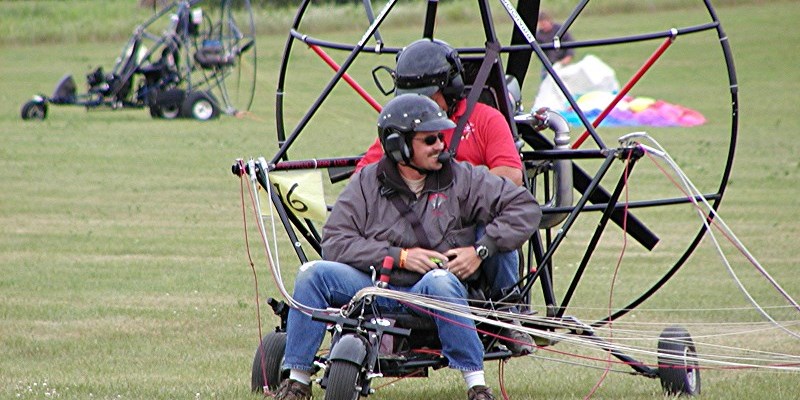Powered Parachuting (PPC)
Ok.You’re here! That means, you either have the desire to know more about the sport and fun of powered parachuting, or, you just have a lot of time on your hands. Whatever the case, let's investigate what PPC'ing is all about.
On the surface, it appears to be a go-kart looking thing, with a propeller in back, sitting on three or four wheels and tires. The propeller appears to be connected to an engine. OK, now where's the parachute? Sitting in the seat, of course!
It is considered an ultralight plane, for it is suspended under a wing-style parachute, using the engine for ascent and descent with two bars up front for steering. The engine is also used right at the beginning of the flight, coupled with the forward motion of the frame and the prop wash from the propeller to inflate (called kiting) the chute. Once directly overhead, it's time to give it the gas and lift off to your desired height.
It is, however, a bit more involved.
Taking a closer look, the frame is usually made out of plated, metal tubing, supported at a variety of different contact points throughout the craft. Following a basic flow for strength and support, and depending on the manufacturer, the craft has one (or two) wheels in front, followed by two bars that stick out in front (for steering with your feet), an instrument panel with gauges and such, a seat, (or two, if it is a two-seater) two controls for ground steering and engine speed, a gas tank, and an engine with a two, three or four blade propeller. Around the propeller, there are round prop rings to protect people from walking into the prop and to protect the prop from other things bouncing into it.
Just behind the center line of the craft, are attach points, near the top, that are connected to the parachute, through lines called risers and then to the actual lines that hook to the parachute. When not used, the parachute usually rests in a protective bag, sitting on the seat or strapped to one of the tubes, depending on the design of the bag.
Powered parachutes like calm air; you really don't want to go up went the wind is gusty or more than 15 MPH. Sometimes ( a lot of times!) Wisconsin weather does not cooperate and then die-hard PPC'ers talk the talk, or look at flying pictures or videos that they have taken or purchased. Yes, it gets this bad (cannot fly) sometimes! :(
When the wind is calm enough and you are in the right frame of mind to fly, the PPC is either trailered to a farmer's field or (if you are lucky) you can fly right from your back yard. The craft is then pre-flighted, which means to say that every screw, bolt, nut, and piece is gone over to make sure it's all tight, filled, pumped up, and ready to roll. Then, the engine is started and taken to a certain temperature to make sure there are no problems. In the meantime, you put up your windsock, or other wind-direction/speed device, check the batteries in the radio, get your helmet out and dress for the day's temperature.
Once the engine is warmed up, the PPC is un-strapped and unloaded from the trailer and pushed or driven to a place for take-off. It is always pointed into the wind! The chute bag is then place behind the craft, just like it was in the seat (do not turn!), dumped out on the ground, and placed in an arc on the ground.
Putting your helmet on, you do another check of the lines and risers, make sure your radio is working, the strap yourself in the seat.
Ready? Give it half gas, look up to see that the parachute is overhead, with all the cells filled with air and no lines tangled, then give it the gas, making sure your craft is steering straight in to the wind. You should be airborne!!
Fun, wasn't it!
OK. You're up 500 feet now, time to level off. Want to go right? Push the right steering bar with your right foot. Want to go left? Push the left steering bar. Hands still clutched on the steering and throttle controls? Relax! There's nothing for them to do now. Except, be ready for when you need the throttle. Those trees or power lines might be coming up too quickly!
Ready to land? OK. First do a fly-by of your windsock so see what direction the wind is coming from. Most likely, it's changed! Give yourself lots of room. The trick is to descend and make your landing with as little angle as possible. You'll land more smoothly and without bouncing yourself out of the seat. You're almost down now. Give it a bit more gas so you're just skimming the field. Just about there? Make sure your hand is on the steering control and the front wheel(s) are pointed straight ahead. At the point of impact with the ground, cut the throttle, and reach out to grab both steering lines, pulling forward. This will pull the chute lightly behind you, so you're all ready for another flight, or to put the chute away.
All done for the day? OK Pack the chute in the bag, put it on your craft and if you're close enough, push it on the trailer, cinch it down, put away the accessories and then STOP SMILING! Or not! You've just experienced your solo flight in the powered parachute!


